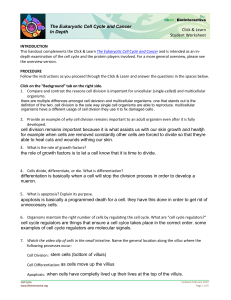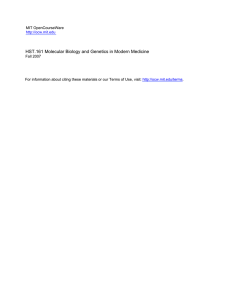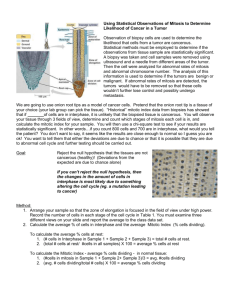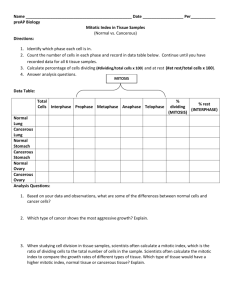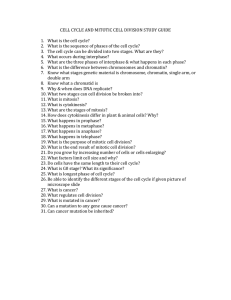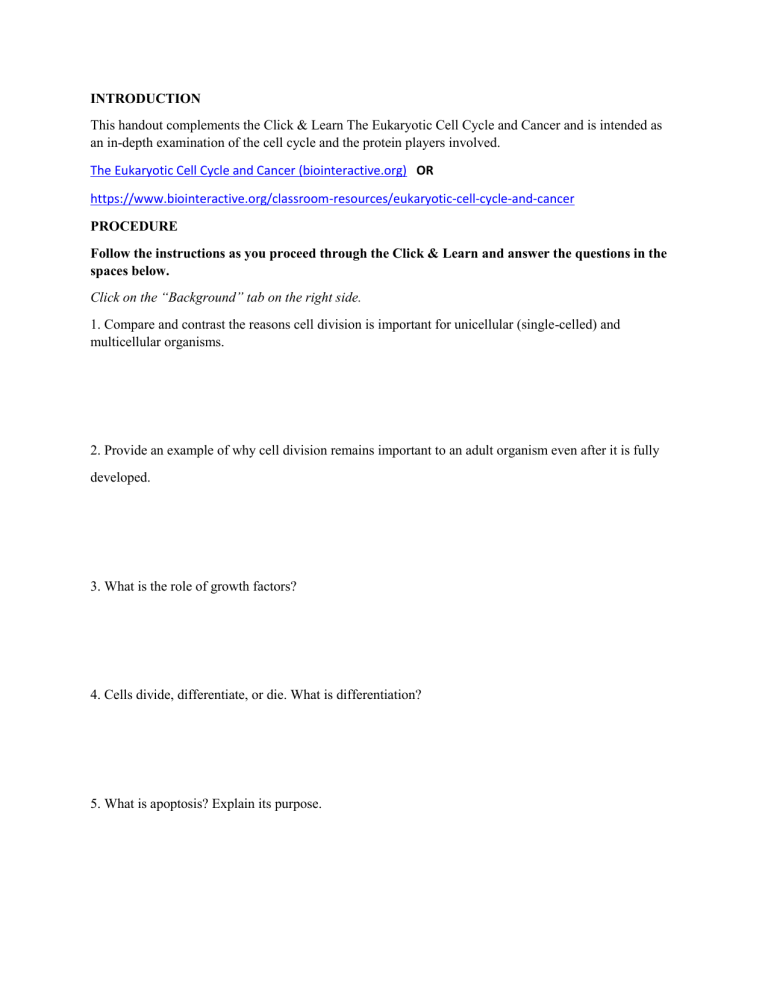
INTRODUCTION This handout complements the Click & Learn The Eukaryotic Cell Cycle and Cancer and is intended as an in-depth examination of the cell cycle and the protein players involved. The Eukaryotic Cell Cycle and Cancer (biointeractive.org) OR https://www.biointeractive.org/classroom-resources/eukaryotic-cell-cycle-and-cancer PROCEDURE Follow the instructions as you proceed through the Click & Learn and answer the questions in the spaces below. Click on the “Background” tab on the right side. 1. Compare and contrast the reasons cell division is important for unicellular (single-celled) and multicellular organisms. 2. Provide an example of why cell division remains important to an adult organism even after it is fully developed. 3. What is the role of growth factors? 4. Cells divide, differentiate, or die. What is differentiation? 5. What is apoptosis? Explain its purpose. 6. Organisms maintain the right number of cells by regulating the cell cycle. What are “cell cycle regulators?” 7. Watch the video clip of cells in the small intestine. Name the general location along the villus where the following processes occur: Cell Division: Cell Differentiation: Apoptosis: 8. Name one harmless result of too little cell division. 9. Name one harmless result of too much cell division. Click on the section of the circle labeled “Cell Cycle Phases” in the center purple circle on the right and use the “Overview” information in the window on the left to answer the questions below. 10. List, in order, the four events we collectively call the “cell cycle.” Next to each event, write the correlating cell cycle phase name. a. b. c. d. 11. In general, what is the purpose of a checkpoint in the cell cycle? 12. What is one potential outcome when errors occur in this highly regulated cell cycle process? Click on “Cell Cycle Regulators and Cancer” in the center purple circle on the right. Use the information under “Regulators Overview” in the window on the left to answer the questions below. 13. What type of protein that regulates the cell cycle is encoded by proto-oncogenes? 14. What type of protein that regulates the cell cycle is encoded by tumor suppressor genes? 15. The most important cell cycle regulators are the ______________________________________ . 16. What is a kinase, and what does it do? 17. When are CDKs present inside the cell during the cell cycle? 18. When are cyclins present inside the cell during the cell cycle? 19. CDKs form molecular complexes with cyclins. What do activated CDK-cyclin complexes do? Using the cell cycle diagram on the right and both links in the center purple circle, complete the table below for each phase. Complete the entire row before moving on to the next phase. PHASE PHASE EVENTS CHECKPOINT EVENTS G1 S G2 M (mitosis) 20. Go to “Cell Cycle Phases” and click on “Interphase.” The interphase alternates with mitosis. What happens during interphase and what phases does it include? 21. Go to “Cell Cycle Phases” and click on “G0.” The G0 phase is a resting or nondividing stage. What three factors determine if a cell enters G0? 1. 2. 3. 22. Provide an example of a fully differentiated cell that is (a) permanently in G0 and (b) one that can leave G0 to progress through the cell cycle and divide again. a. b. Click on “Cell Cycle Regulators and Cancer” in the center purple circle on the right. Then click on the “Cancer Overview” tab in the window to the left (right tab). 23. Cancer is an improperly regulated cell cycle. Name two reasons why cells can form tumors. 24. What causes uncontrolled cell division at the genetic level? 25. Watch the video clip. At the cellular level in this example, explain what occurs if the APC gene is mutated. 26. Normally, proto-oncogenes stimulate the cell cycle. What do mutated proto-oncogenes (i.e., oncogenes) cause? 27. Normally, tumor suppressor genes inhibit the cell cycle. What do mutated tumor suppressor genes cause? 28. To cause cancer, proto-oncogenes require ___ 1 (or) ___ 2 allele(s) to be mutated and are therefore considered ___ dominant (or) ___ recessive. This results in a ___________ of function. 29. To cause cancer, tumor suppressor genes require ___ 1 (or) ___ 2 allele(s) to be mutated and are therefore considered ___ dominant (or) ___ recessive. This results in a ___________ of function. 30. Watch the video clip. a. Using the gas pedal analogy, explain the impact on the cell cycle of a proto-oncogene versus an oncogene. b. Using the brake pedal analogy, explain the impact on the cell cycle of one mutated tumor suppressor gene allele versus two mutated tumor suppressor alleles. Now that you have finished the Click & Learn, use your knowledge to answer the following questions. 31. p53 is a protein that is encoded by a tumor suppressor gene, and some scientists refer to it as “the guardian of the genome.” a. Explain its normal role and why scientists would regard it as the “guardian of the genome.” b. Explain what happens to the cell cycle if both alleles of the gene encoding p53 are mutated. 32. Explain why people who inherit one mutated allele of the BRCA1 gene have a higher likelihood of developing cancer. The Cell Cycle and Cancer Virtual Lab 1. Open the virtual lab link below. (http://www.mhhe.com/biosci/genbio/virtual_labs_2K8/labs/BL_03/index.html ) 2. Click on the “Information” button and read about cancer. Answer the first set of questions on the lab sheet. 3. Click on the microscope in the lab simulation to examine the different types of tissues. Click on the tissue box to switch between the six tissue types available. Follow the instructions to label (drag and drop) each tissue sample. 4. Record the total number of cells in the sample and the number of cells in each phase of the cell cycle on the data table. 5. Calculate the mitotic index (total # of cells in a mitosis phase ÷ total number of cells in the sample). 6. Calculate the percent of cells at rest (total # of cells in interphase ÷ total number of cells in the sample). 7. Answer the analysis questions. Tissue Sample Normal Lung Total Cells Interphase P M A T Cancerous Lung Normal Stomach Cancerous Stomach Normal Ovary Cancerous Ovary Analysis Questions: 1. Based on your data and observations, what are some of the differences between normal cells and cancer cells? Mitotic Index % at Rest 2. When studying cell division in tissue samples, scientists often calculate a mitotic index, which is the ratio of dividing cells to the total number of cells in the sample. Which type of tissue would have a higher mitotic index, normal tissue or cancerous tissue? Explain. 3. Different types of normal tissues in the human body have different mitotic indices. From the following list, which normal tissues would you expect to have the highest mitotic index: muscle, skin, kidney, or lung? Explain your answer.
